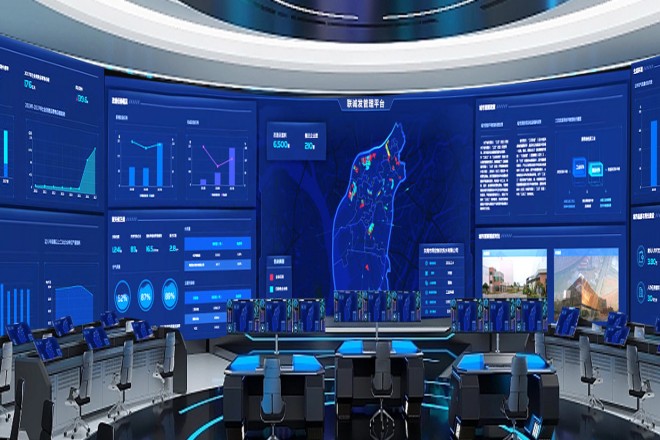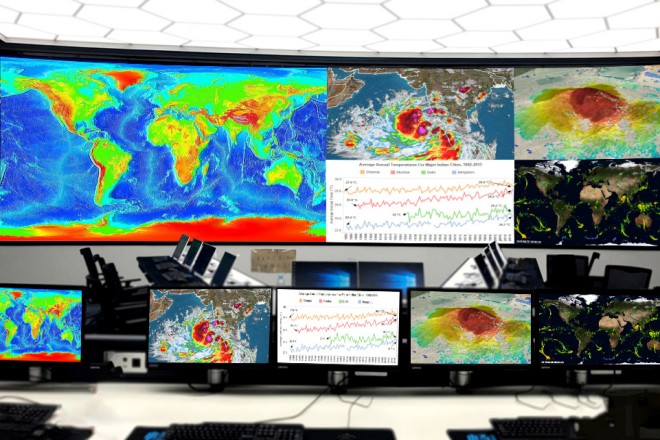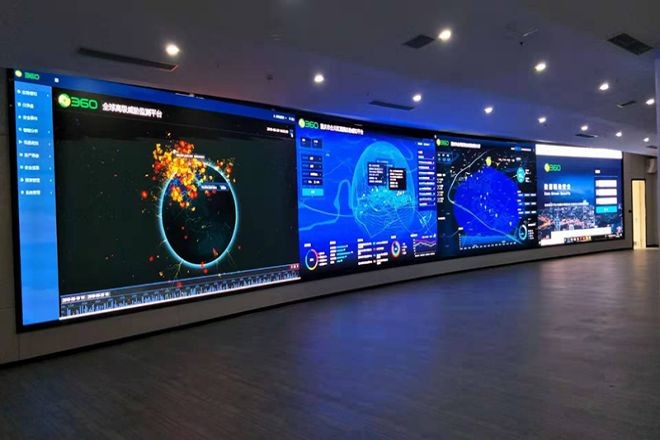介绍

在指挥中心,信息显示的每一秒都至关重要。作为信息传递的核心工具,显示屏的性能 LED显示屏 直接影响决策的效率和准确性。
随着科技的发展,LED显示屏的功能已由单一的图像显示发展到现在的高清视频、实时数据监控、互动操作等功能。但随着功能的增加,对显示屏的性能要求也越来越高。
本文将探讨如何优化控制中心的LED显示屏,以保证信息传输的高效率和高可靠性。
1、LED显示屏在控制中心的作用

在繁忙复杂的控制中心环境中,LED显示屏就像一个巨大的信息窗口,向所有相关人员清晰地呈现关键数据、实时情况以及应急指令。
1). 实时信息显示:清晰的信息窗口
想象一下,控制中心可能有多个系统同时运行,比如监控系统、环境监控系统、生产管理系统等等,每个系统都在不断地产生数据。
LED显示屏就像一个超大的电子公告板,可以将这些数据以图形、文字、数字等形式实时的显示出来。例如在环境监测系统中,显示屏可以实时显示温度、湿度、空气质量等参数。
在生产管理系统中,可显示生产线的运作状况、生产统计等资讯,让工作人员只需抬头就能快速掌握目前状况,无须逐一查看各个系统的显示屏或报表。
2). 数据监控:24小时守护
LED显示屏不仅显示数据,还承担着数据监控的重任,它就像一位不知疲倦的哨兵,24小时不间断地监测着各种数据的变化。
一旦出现数据异常,比如某个监测点的温度突然升高、某些设备的运行参数超出正常范围等,显示屏就会以醒目的方式(如变色、闪烁等)提醒工作人员。
这样,工作人员就能立即发现问题,并采取措施,防止事态进一步恶化。
3). 紧急通报:危机报警
紧急情况下,时间就是生命,LED显示屏可以第一时间把紧急信息传达给大家,比如发生火灾,显示屏会立刻显示“火警!”
请立即撤离!”并伴有强烈的警报声,这样工作人员和游客都能迅速做出反应,按照预定的疏散路线安全撤离。
同样,在自然灾害、设备故障等紧急情况下,显示屏也能发挥同样的作用,保证信息的及时传达和有效的应对。
4). 作战指令传输:精准指挥
在控制中心,经常需要对多个系统或设备进行远程操作,LED显示屏可以作为远程操作指令的显示平台。
当需要进行某项操作时,工作人员只需要在控制台上输入指令,该指令就会立即显示在LED显示屏上。
同时,显示屏还可以显示操作的详细步骤、注意事项、预期结果等信息,这样操作人员就可以清楚地了解操作要求,并按照指令准确无误地执行操作。
这不仅提高了工作效率,而且降低了误操作的风险。
2. 控制中心LED显示屏当前面临的挑战和要求
1).高清化要求
想象一下,您在控制中心,需要监控来自多个摄像机的图像或查看详细的生产数据图表。
如果显示屏的清晰度不够高,则画面中的细节可能会变得模糊,例如脸部变得难以识别,数据图表中的线条和文字也可能变得难以阅读。
因此,您需要一台高清 LED 显示屏。它就像您家里的高清电视,但要求更高,因为它需要清晰地显示更多信息,并显示更精细的细节。高清显示屏可确保每个像素都清晰可见,无论是复杂的图像还是微小的文本。
2). 响应时间快
在控制中心,时间就是效率。如果您正在监控紧急情况,例如火灾或设备故障,显示器的响应时间就变得至关重要。如果显示器更新数据或警报信息的速度太慢,您可能会错过最佳响应时间。
因此,您需要一款响应时间快的LED显示屏。这意味着当有新数据或警报信息时,显示屏可以立即更新和显示,让您快速做出反应。
就像我们在玩电子游戏的时候,如果游戏画面卡住了,我们会感觉很不舒服;同样,在控制中心,我们也需要一个流畅、通畅的显示,以保证信息的实时性。
3).高可靠性
控制中心通常需要24小时不间断运行,这就要求显示屏具有极高的可靠性,如果关键时刻显示屏出现故障,可能会导致整个控制中心陷入瘫痪,造成无法估量的损失。
因此,需要高可靠性的LED显示屏,即显示屏需要采用优质的材料和先进的制造工艺,以保证其长期稳定的运行。
同时需要建立完善的监控和维护机制,预防故障,并在发生故障时快速恢复运行。就像你家里的灯,虽然你很少注意到它的存在,但它需要一直可靠地工作,为你提供光亮。
4). 操作简便
控制中心的操作人员可能来自不同的专业领域和背景,对显示屏的操作界面和操作流程可能有不同的理解和习惯。
如果显示器的操作过于复杂或者不符合他们的使用习惯,可能会增加他们的操作负担,增加出错的风险。
因此,您需要一款易于操作的 LED 显示屏。这意味着显示屏的控制界面需要设计得直观、简洁、易懂,以便操作员能够快速上手并准确操作。
同时需要提供丰富的帮助文档和培训资源,支持运营商的学习和使用。
就像你使用手机或者电脑一样,即使你之前没有使用过某个特定的应用或者功能,只要界面设计得足够友好、提供足够多的帮助信息,你就能很快掌握它。
3.控制中心LED显示屏优化策略

1). 改进 解决
当我们说提高分辨率时,我们的意思是选择像素更密集、可以显示更多细节的 LED 显示屏。
想象一下,你正在看一幅画,如果画上的线条和色块很大,细节就会丢失,但如果线条和色块小而细,你就能看清更多细节。
同样的道理,高分辨率的LED显示屏就好比一幅精美的画作,能够展现更多的图像细节,比如更清晰的文字、更细腻的图像边缘等等。
- 优点:
清晰度越高,信息就越容易识别和理解。
提高了工作效率,因为操作员不需要花费额外的时间来识别模糊的信息。
2). 增强型 亮度 调整
亮度调节功能可以让我们根据环境光的变化来调节LED显示屏的亮度,在白天光线较强的时候,我们可以提高显示屏的亮度,保证信息清晰可见。
而在夜晚或室内光线较暗的环境下,可以降低亮度以减少眩光,节省能源。该功能可以是自动的,通过传感器感应环境光,自动调节亮度;也可以是手动的,操作人员根据需要进行调节。
- 优点:
提高不同光线条件下显示屏的可见度。
有助于节省能源并减少消耗,尤其是在弱光环境下。
3). 提高色彩准确度
色彩准确度是指显示器准确还原原始图像或视频中色彩的能力。为了确保色彩准确度,我们需要定期校准显示器。
这通常需要使用专业的色彩管理软件和校准设备来精确测量和调整显示器的色彩,以确保其色彩表现与原始图像一致。
- 优点:
提高显示器的色彩还原度,使图像更加逼真。
帮助控制中心人员更准确地识别图像中的信息。
4). 升级硬件
随着时间的流逝,LED显示屏的硬件部件可能会因老化、磨损或技术进步而变得陈旧。为了保持显示屏的最佳性能,我们需要定期检查和更换老化的硬件部件。
这可能包括LED灯珠、电路板、电源等关键部件,通过硬件的升级,可以提高显示屏的亮度、对比度、色彩还原等关键指标,同时也有助于延长显示屏的使用寿命。
- 优点:
提高显示器的整体性能和稳定性。
延长显示器的使用寿命,降低更换成本。
5). 软件升级
软件升级是指为LED显示屏的控制软件安装新版本或补丁,以修复已知问题、添加新功能或提高性能。这通常可以通过从网络下载更新包并将其安装在显示屏控制系统中来完成。
软件升级对于维持显示器的兼容性和安全性至关重要,因为新软件版本可能包括对新操作系统、新文件格式或新安全威胁的支持。
- 优点:
提高了显示器的兼容性和性能。
增强显示器的安全性,降低黑客攻击的风险。
6). 冗余系统设计
冗余系统设计是指在控制中心设置备用LED显示屏或关键部件,以便在主显示屏或部件发生故障时,可以快速切换到备用设备。
这种设计类似于为计算机配置备用电源或硬盘,以提高系统的可靠性和稳定性。在冗余系统中,主、备显示器通常连接在同一控制系统中,可以在需要时自动或手动切换。
- 优点:
提高了控制中心的可靠性和稳定性。
减少因显示故障造成的中断和损失。
结论
优化控制中心的LED显示屏不仅仅是一个技术升级的过程,它也是一个提高整体业务性能和响应能力的过程。
通过升级和维护显示器的分辨率、亮度、色彩精度、硬件和软件,我们可以确保控制中心能够随时提供清晰、准确、实时的信息。
这样的优化不仅提高了操作的便捷性和效率,也增强了调度中心应对突发事件的能力。
最后,如果您想了解更多关于LED显示屏的知识, 请与我们联系。
